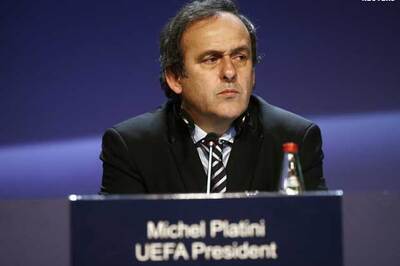
views
Pakistan’s economic trajectory has been in a downward spiral for years, compounded by mounting external debts owed to various international entities. At the forefront of this fiscal debt quagmire are its substantial obligations to several Chinese state entities. This complex situation has put Pakistan in a vicious cycle where it is forced to avail new loans to offset existing ones. This has become a major contributory factor to Pakistan’s prevalent economic turmoil.
However, amidst this financial turbulence, what’s alarming is the glaring absence of substantial public scrutiny within Pakistan’s media, despite significant local discontent towards overarching Chinese presence. This lack of examination underscores both the limited bandwidth within which the Pakistani media operates and a growing trend of China’s far-reaching efforts to suppress any of its negative portrayal in the press.
An investigative report, “Narrative Craftsmanship: China’s Strategic Influence on Pakistani Media Circles”, released in November 2023, shed light on Beijing’s strategic manoeuvres to control the narrative surrounding its engagements, notably the China-Pakistan Economic Corridor (CPEC). Despite its promotion as a landmark investment promising economic development, CPEC, launched in 2013 and an important leg of President Xi Jinping’s Belt and Road Initiative (BRI), has incited major discontent across various regions in Pakistan, especially the restive Balochistan. However, the report revealed a stark contrast between how Pakistani media covered CPEC compared to international media outlets.
While it credited the international outlets for objectively reporting on and evaluating CPEC’s stated goals against its actual progress, the report highlighted that the Pakistani mainstream media conspicuously showcased only the purported ‘positives’ of the project, disregarding local dissent and its failure to deliver on economic promises. More significantly, the Pakistani media appeared to sidestep allegations of a potential debt trap associated with Chinese investments through largely secretive yet ambiguous conditions, instead applauding the Chinese loans as acts of goodwill.
However, these findings should not surprise people given this pattern aligns with the modus operandi of China as manifested across Asia and Africa through its Belt and Road Initiative (BRI), wherein media manipulation plays a substantial role. In the case of Pakistan and prior to the launch of the economic corridor, Beijing nurtured Islamabad-based Pakistan-China Institute (PCI). The Institute was founded by PML-N senator Mushahid Hussain in 2009, to advocate for the enhanced China-Pakistan relations “in all areas particularly defence and diplomacy, education and energy, economy and environment”.
Over the years, the institute took charge of promoting the BRI and CPEC by establishing a number of news portals and forging relations between media institutions in the two countries. This included initiatives like the CPEC Portal in collaboration with the China Radio International (CRI) to “disseminate information” and “enhance stakeholder connectivity” regarding CPEC. Others include, Youlinmagazine.com (Pakistan’s first and only bilingual cultural website (English and Chinese), Nihao-Salam.com (daily news feed website), and ACCA Global (research repository of BRI).
Additionally, the institute launched the CPEC Media Forum in November 2015 to counter negative news related to Chinese investments in Pakistan and shape reporting directives on CPEC and BRI in view of local protests against the growing presence of Chinese companies. Ever since, the forum has played an important role in convening important “political decision-makers and journalists from China and Pakistan to shape reporting directives on the CPEC and BRI.”
Moreover, in December 2018, PCI launched the Rapid Response Information-Exchange Network (RRIN) in collaboration with the Beijing-based economy related major news website, China Economic Net, “to counter the negative propaganda in the media on #CPEC and #BRI.” As per the Pakistan-China Institute, this joint initiative further aimed to present the rightful information about the CPEC projects and construct a positive narrative about Islamabad-Beijing strategic relations. These interventions have been made to ensure a localised narrative building is done by sponsoring these projects and their public events.
In addition to the above interventions, the extent of Beijing’s media outreach can be gauged by the fact that its major news agencies and outlets have started offering content in Urdu language to connect with audiences in Pakistan and beyond to ensure its narratives are disseminated widely. For instance, in December 2019, the state run Xinhua News Agency extended ‘Xinhua-All-Media-Services’ to Pakistani news agencies, that allowed a free “access to its all news services comprising photo, text, graphic, and video, etc, for the twin print and electronic media and in both English and Urdu languages.” This information access effectively enabled China to infiltrate its narrative into the Pakistan mainstream media, which have otherwise limited financial capital to report international events or buy content from the international agencies.
As such, the financial incentives from China led to a concerted effort in Pakistani media to portray Chinese interventions positively, emphasising infrastructural development and bilateral relations while glossing over debt issues fostered economic crisis along with local discontent over these economically unfeasible projects. As the above cited report highlights, as the BRI completed 10 years in Pakistan in 2023, its anniversary saw an enhanced push by Pakistani media to promote the project as a remarkable success in the country and China as a benevolent bilateral partner. The report held that the examined media content conveniently glossed over Pakistan’s crushing debt issues with Beijing even as the country’s battles severe economic crisis and remains at the cusp of a financial default.
What transpires from the reports of the Pakistani media is its overwhelming defence of Chinese interventions, including concerted efforts to dismiss accusations such as debt trap or contest the veracity of the allegations of mass protests by locals against the CPEC projects, especially in restive regions of Balochistan and tribal areas. For instance, an August 2023 article in Express Tribune labelled the debt-trap related criticism of the BRI as “reflective of an adversarial mindset” and did a disservice by overlooking the project’s fundamental objective of “the betterment of the locals.” It commends China for continuing its project engagements despite a number of challenges like terrorism that has historically restrained foreigners from investing in the country. It is worth mentioning that a number of Baloch resistance groups have attacked Chinese companies operating in the region which has left a number of Chinese nationals dead. Likewise, an article by a former diplomat Hassan Daud Butt in an online portal credits China for creating “over 100,000 opportunities for employment, 6,000 MW of electricity and over 510 KMs roads creating rural-urban synergy and regional connectivity” in Pakistan.
The glaring defence of China is manifested even when protests surfaced against the Chinese presence with the Pakistani mainstream media often discrediting them as politically motivated rather than genuine expressions of dissent. In particular, when the international media reported mass protest in Gwadar region by fishermen and local traders, organised under Haq Do Tehreek (HDT), against the authorities for issuing licences to Chinese fishing trawlers in December 2022, the Pakistani mainstream media remained at the forefront of dismissing the allegations outrightly. Pertinently, a Dawn article on December 26, 2022, labelled the protests as manufactured by the HDT leader, Maulana Hidayatur Rehman, for his political aspirations and hence devoid of any degree of genuineness.
These intricate machinations of China have unleashed a major change in the Pakistani media landscape, which has gradually transitioned from mere importing and propagation of Chinese media content to outright adoption of Beijing’s narratives not only on global issues but even those related to Pakistan itself. It further points to how this control has allowed China to manage the criticism around its contested engagements in the country that have drawn widespread local resentment.
The writer is an author and columnist and has written several books. He tweets @ArunAnandLive. Views expressed in the above piece are personal and solely that of the author. They do not necessarily reflect News18’s views.


















Comments
0 comment